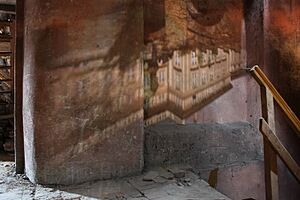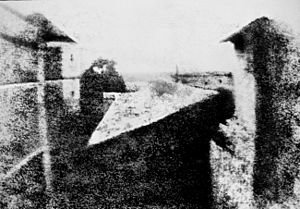View from the Window at Le Gras facts for kids
The View from the Window at Le Gras (which means "View from Le Gras" in French) is a very special image. It's the oldest surviving photograph ever taken by a camera! A French inventor named Nicéphore Niépce created it between 1822 and 1827. He took the picture from a high window at his home in Saint-Loup-de-Varennes, France. It shows parts of his buildings and the countryside around his estate, called Le Gras.
Contents
How Was the First Photo Made?
Niépce used a special device called a camera obscura to capture the scene. Imagine a dark room or box with a tiny hole. Light from outside goes through the hole and projects an upside-down image onto the opposite wall.
He placed a thin sheet of pewter metal, about 16 by 20 centimeters, inside the camera. This plate was covered with a natural tar-like substance called bitumen of Judea. When bright light hit the bitumen, it became hard. But in areas where there was less light, it stayed soft.
After a very long time, Niépce washed the plate with a mix of lavender oil and white spirit. The soft bitumen washed away, but the hard parts remained, creating the image.
Scientists believe the camera had to stay open for many hours, maybe even several days! This is why the sunlight in the photo seems to hit buildings on both sides at once.
The Photo's Journey Through Time
In late 1826, Niépce visited the United Kingdom. He showed this photograph and other works to an artist named Francis Bauer. The "View from the Window at Le Gras" was the only actual camera photograph. The others were copies of art made by placing them directly on the plate.
Bauer encouraged Niépce to show his new "heliography" process to the Royal Society. Niépce wrote a paper, but he didn't want to share all his secret details. Because of this, the Royal Society said no to his presentation. They had a rule against talking about secret processes.
Before going back to France, Niépce gave his paper and the photos to Bauer. Sadly, Niépce passed away suddenly in 1833.
After other photography methods were announced in 1839 by Louis Daguerre and Henry Fox Talbot, Bauer worked hard to make sure Niépce got credit. He wanted everyone to know Niépce was the first to invent a way to make permanent photographs.
On March 9, 1839, Niépce's photos were finally shown at the Royal Society. After Bauer died in 1840, the photo was owned by different people. It was sometimes shown as a cool old item. The "View from the Window at Le Gras" was last seen in public in 1905. Then, it was forgotten for almost 50 years.
Rediscovering the First Photograph

In 1952, historians Helmut Gernsheim and his wife, Alison, found the photograph again. They made it famous, proving that Niépce was indeed the inventor of photography.
They asked experts at the Kodak Research Laboratory to make a modern copy. It was very hard to make a copy that showed everything that could be seen on the original metal plate.
Helmut Gernsheim later made one of the copies look much better by touching it up. He wanted the scene to be easier to understand. For many years, only this improved version was allowed to be published.
Later, people noticed that the original plate had gotten some bumps near its corners after 1952. These bumps made it harder to see parts of the image because of how the light reflected.
In the 1950s and early 1960s, the Gernsheims took the photograph to several exhibitions in Europe. In 1963, a man named Harry Ransom bought most of the Gernsheims' photo collection for the University of Texas at Austin.
The photo doesn't travel much anymore. But in 2012–2013, it went to Mannheim, Germany, for an exhibition. Usually, you can see it on display in the main lobby of the Harry Ransom Center in Austin, Texas.
Why Is This Photo So Important?
In 2003, Life magazine included View from the Window at Le Gras in its list of 100 Photographs that Changed the World. An article in Art on Paper magazine also said it has a "fair claim" to be the very first photograph ever made. It truly changed how we see and record the world!
See also
- History of photography
- List of photographs considered the most important




